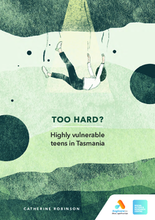Executive Summary
This project emerged in response to growing disquiet in Tasmania about the experiences of a cohort of highly vulnerable teens (aged 10-17 years) whose needs for care have fallen outside of families, between government agencies and between non-government services. This is a cohort of young people who concurrently experience lifetime trajectories of cumulative harm, repeat homelessness, limited education, contact with police and youth justice, and repeat child protection notifications.
Importantly, this is a cohort not on Care and Protection Orders and for which placement in out-of-home care is often considered too challenging given limited appropriate placement options, the ages of the young people, and the highly complex needs they present.
These highly vulnerable young people move between unstable familial and friendship environments, they couch surf, and are episodically unaccompanied in Specialist Homeless Services (SHS). They live with no or little income and are excluded from mainstream and, potentially, alternative schooling. Instead they are engaged with police and Youth Justice and face escalating crises in mental and physical health. They misuse drugs and alcohol and remain exposed to further violence and trauma.
The Social Action and Research Centre (SARC), Anglicare Tasmania, undertook to investigate and document why and how some teens in Tasmania come to experience such extraordinary hardship and prolonged precarity. This report presents the findings of that investigation, considering both contexts of individual vulnerability and available support systems and services. It unravels the fundamental paradox that those most vulnerable – both developmentally and in terms of the layers of adversity they experience – seem to be at best retained, and at worst entrenched, in vulnerability. As such, the report frames young people’s experiences of high vulnerability as a key social justice challenge for Tasmania. It names the gaps in care received by this cohort, and recommends some key ways in which these can be filled.

